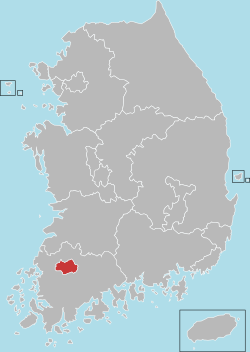Kwangju
|
Gwangju 광주시 |
|||
|---|---|---|---|
| Metropolitan City | |||
| Gwangju Metropolitan City | |||
| transcription(s) | |||
| • Hangul | |||
| • Hanja | |||
| • Revised Romanization | Gwangju-gwangyeoksi | ||
| • McCune-Reischauer | Kwangju-kwangyŏksi | ||

Downtown Gwangju from city hall
|
|||
|
|||
 Map of South Korea with Gwangju highlighted |
|||
| Country |
|
||
| Region | Honam | ||
| Districts | 5 | ||
| Government | |||
| • Mayor | Yoon Jang-hyeon | ||
| Area | |||
| • Total | 501.24 km2 (193.53 sq mi) | ||
| Population (October, 2014) | |||
| • Total | 1,477,780 | ||
| • Density | 2,900/km2 (7,600/sq mi) | ||
| • Dialect | Jeolla | ||
| ISO 3166 code | KR-29 | ||
| Flower | Royal Azalea | ||
| Tree | Ginkgo | ||
| Bird | Dove | ||
| GDP | US$ 36.7 billion | ||
| GDP per capita | US$ 24,520 | ||
| Website | gwangju.go.kr | ||
Gwangju (Korean pronunciation: [kwaŋ.dʑu]) is the sixth largest city in South Korea. It is a designated metropolitan city under the direct control of the central government's Home Minister. The city was also the capital of South Jeolla Province until the provincial office moved to the southern village of Namak in Muan County in 2005.
Gwang (광, Chinese letter: 光) means "light" and Ju (주, Chinese letter: 州) means "province." Areas of scenery along the outskirts of the city gave birth to gasa, a form of Korean classical poetry. Located in the center of the agricultural Jeolla region, the city is also famous for its rich and diverse cuisine.
The city was established in 57 BC. It was one of the administrative centres of Baekje during the Three Kingdoms Period.
In 1929, during the period of Japanese rule, a confrontation between Korean and Japanese students in the city turned into a regional demonstration, which culminated in one of the major nationwide uprisings against Japanese rule during the colonial period.
Modern industry was established in Gwangju with the construction of a railway to Seoul. Some of the industries that took hold include cotton textiles, rice mills and breweries. Construction of a designated industrial zone in 1967 encouraged growth in industry, especially in the sectors linked to the automobile industry.
In May 1980, peaceful demonstrations took place in Gwangju against the newly installed military government of Chun Doo-hwan. The demonstrations were suppressed by military forces, including elite units of the Special Operations Command. The situation escalated after a violent crackdown, resulting in the Gwangju Uprising, where the civilians raided armories and armed themselves. By the time that the uprising was suppressed, many hundred civilians and several policemen / soldiers were dead. After civilian rule was reinstated, a national cemetery was established honouring the victims of the incident.
...
Wikipedia


